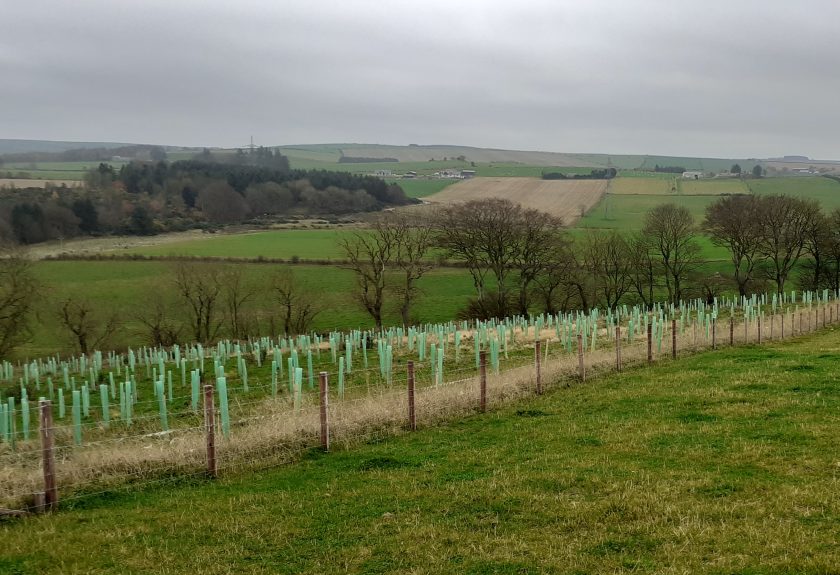
Farmers and landowners are being urged to look into woodland planting as it could be the 'root' to securing environmental support payments.
Trees have also been linked to increased agricultural productivity, according to SAC Consulting, part of Scotland’s Rural College (SRUC).
As shelter for livestock, they can reduce incidence of mastitis in ewes and hypothermia in lambs. For arable farms, trees can reduce wind damage to crops.
It was this unique mix of benefits that led John Lamont, a farm manager in Aberdeenshire, to plant over 11,000 broadleaved trees last year.
“It was a joint decision with the landowner. We’re both keen on encouraging wildlife and wanted to further diversify habitats on the farm.
"We built a pond over 15 years ago and were looking for something else that would enhance the look and feel of the place.
“We also had some fields that would benefit from that shelter trees offer, as well as some damper areas where trees could help with drainage.”
West Crichie, the 525 acre - predominantly arable - unit near Stuartfield also finishes 300 Aberdeen Angus stores and fattens 500 Cheviot cross lambs from the west coast each year.
“We were nearly entirely advised by SAC Consulting - from the funding application to what to plant and where,” explains John.
“We spent half a day walking around the farm, with a rough map I’d drawn, discussing my ideas. On the whole we didn’t change much, but there were a few surprises.
"Altering the angle of a fence line, for example, increased the amount of shelter the trees would provide and I was surprised that beech wasn’t recommended as a species.”
According to SAC Consulting’s forestry consultant, Ben Law, beech has had an 'identity crisis' in recent years.
Beech trees found in Scotland were thought to have descended from foreign stock planted in Victorian gardens and avenues.
More recent genetic research from the University of Stirling shows the vast majority of trees tested are descended from trees native to Britain.
“Beeches are not currently considered a ‘native’ species for new plantings,” explains Ben. “Though that definition may change in light of the new findings.
“While they are fantastic trees with a number of benefits, a balance must be struck because beech trees colonise rapidly and shade out other species, potentially threatening more sensitive ancient native woodlands.
“Though they can support struggling red squirrel populations, beech trees are not suitable for planting where grey squirrels are present.
"When large-seeded trees such as beech are present, grey squirrels outcompete the native red population.
"Grey squirrels also cause significant damage through bark-stripping of beech trees - weakening and potentially killing the trees they damage.”
Oaks, elms, alder and two varieties of birch were among the species recommended for planting at West Crichie farm.
“Oaks are amazing trees,” says Ben. “They used to form a third of all tree cover in Britain but can be quite picky about conditions.
"Elms are brilliant too, but Dutch elm disease has ravaged the UK population so it’s not a species we plant regularly.
"Birches are very tolerant and hardy trees, they are a ‘pioneer’ species, fast growing and offer dappled shade.
“When it comes to recommending what to plant and where, there’s a huge number of factors to consider.
"Every landowner has their own objectives, and each site is unique. Soil type, exposure to wind and rain, wind throw risk and altitude, are just some of the factors we’ll think about.”
Planting started in October last year and was completed in December by contractor, Gary Davidson.
“In total we planted 15 different sections in a random pattern for a more natural look, with trees fitted with tubes and stakes, to protect them from deer,” recalls Gary.
There are many different approaches to tree planting, which is the best depends on the landowner’s objectives, the tree species and the site.
Planting, into mound is usually used for commercial plantations: “Then there’s staking and tubing, as I did on John’s farm," says Gary.
"Whichever method is used, it’s important to prepare the ground. Not only does that make my job quicker and easier, it helps the growth of the trees."
Once protected, trees require maintenance such as weeding and replacement of any failed trees, and tend to establish well.
“The Rural Payment grant, from Forestry Commission Scotland, covers five years of maintenance as well as the cost of the trees, the planting and some of the fencing costs,” explains John.
“It helps with replacing dead trees, wind damaged stakes and broken plastic shelters, as well as controlling weeds. Those guards are essential to protect the trees from deer and rodents."
“While the youngest lambs have already found shelter along the new fence lines, from the natural growth in the planted areas creating a wind break, it’ll be another four of five years before we really see the shelter benefits.
John says it will then be seven to ten years before farmers see an impact on those damper areas of the farm.
"It’s a long-term project but I’m delighted to be given something back to the land and those that will care for it after me.”
